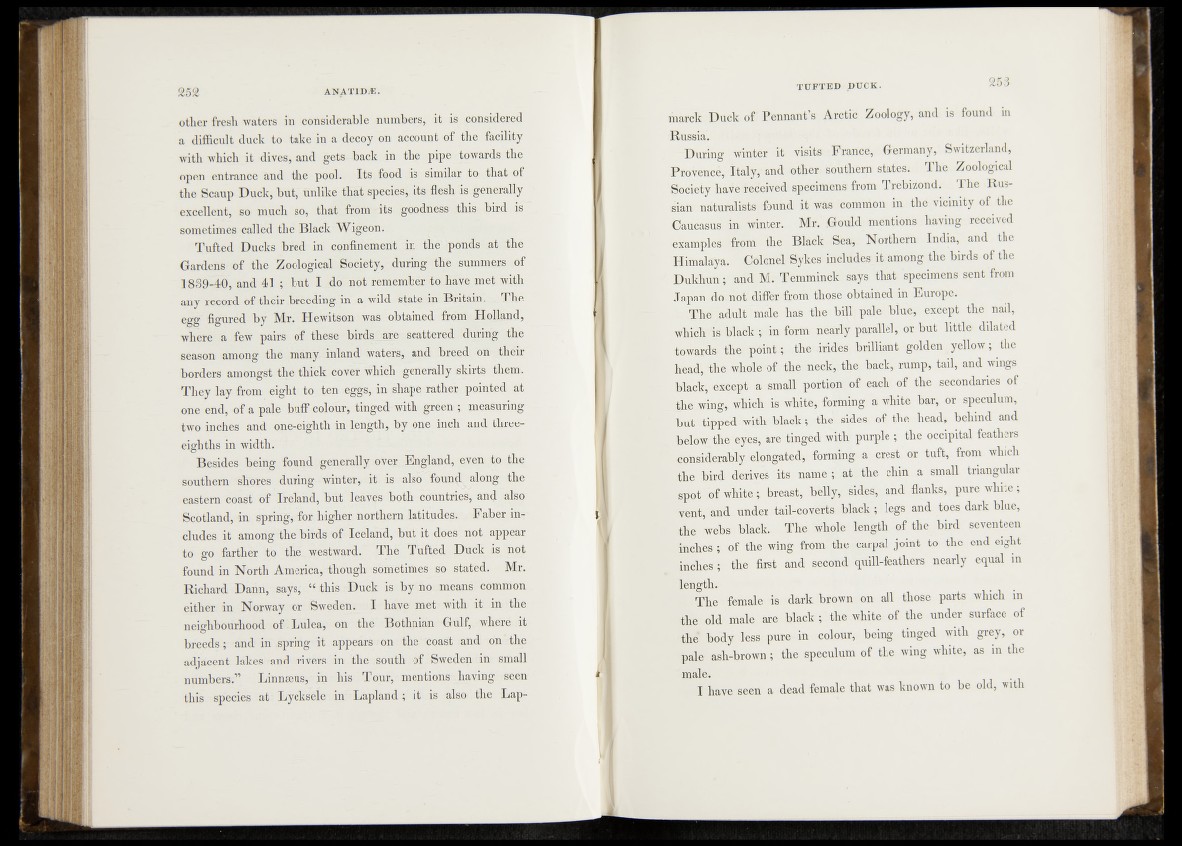
252 a n a t i d j :.
other fresh waters in considerable numbers, it is considered
a difficult duck to take in a decoy on account of the facility
with which it dives, and gets-back in the pipe towards the
open entrance and the pool. Its food is~ similar to that-of
the Scaup Duck, but, unlike that species, its flesh is generally
excellent, so much so, that from • its goodness this bird -is
sometimes called the Black Wigeon.
Tufted Ducks bred in confinement ;in the' ponds at the
Gardens of the Zoological Society, during the summers *of
1839-40, and 41 ; but I do not remember to have met with
any record of their breeding in a wild state in Britain. , The
em figured bv Mr. Hewitson was obtained from Holland,
where a few pairs of these birds' are scattered. during .the
season among the many-inland waters, and bree„d+ on their
borders amongst'the thick cover which generally-skirts them.
They lay from eight to ten eggs, in shape rather pointed, at
one end, of a pale buff colour, tinged with green ; measuring
two inches and oner-eighth in length, by one inch .and three-
eighths in width.
Besides being found generally 0v e r^ n g k n d ,v e ^ n do ;the
southern shores during -winter, it is also foun^along the
eastern coast of Ireland, Unit leaves both ..countries,- and afcscr
Scotland, in spring, for higher northern latitudes. . «Faber, includes
it among the birds of Iceland, but it does not appear
to go farther to the. westward. The Tufted Duck us not
found in North America, though sometimes so stated. Mr.
Richard Dann, :says,'-x‘£this -Duck is by •‘no means common
either in Norway or S w e d e n I haye met' with it in the
neighbourhood of -Lulea, on the BothnianGulf^where it
breeds; and in spring it appears ron ; the ^Cqast and dn>i|^
adjacent lakes. and. rivers in the south of Sweden :.in small
numbers.” Linnaeus, - .in - his Tour, mentions .having seen
this species at Lycksele inLaplaiid ; i i is also the Lapt
u f t e d d u c k . 253
march Duck of' Pennant’s Arctic Zoology, and is found in
Russia.
^During winter it visits France, Germany, Switzerland,
Provence, Italy,- and other southern states. The Zoological
Society have received specimens from Trebizond. The Russian
naturalists found it; was common in the vicinity of the
Caucasus in winter.. Mr.’ .Gould mentions having received
examples ifrom the Black Sea, Northern India, and the
Himalaya. Colonel Sykes includes it among the birds of the
Dukhun; and M. Temminck says that specimens sent from
Japan do-not differ from those obtained in Europe.
The udult male has the bfil pale blue, except the nail,
which Vblack ; in form nearly parallel, or but little dilated
S w a rd s the point-; the .irides brilliant golden _yellow; the
head, 'tfefewhofe of the neck, the back, rump, tail, and wings
black, except a small portion of each of the secondaries of
fch e wingj which is white, forming a white bar, or speculum,
but tipped with black; the sides of the head, behind and
below th e 'e y e s * tin g e d with purple; the occipital feathers
' ’.considerably elongated* forming a crest or tuft, from which
the bird derives its name-;:at the chin a small triangular
vspotlof white ; breast, belly, sides, and flanks, pure white;
vent, and under tail-coverts black; legs and toes dark blue,
the "iwebs black. The whole length of the bird seventeen
inches; of the wing from the carpal joint to the end eight
ly n c h e s ; the first and second quill-feathers nearly equal in
length.
The female is dark brown on all those parts which in
thes old male are black ; the white of the under surface of
the* body less pure in colour, being tinged with grey, or
pale ash-brown ; the speculum of the wing white, as in the
male.
I have seen a dead female that was known to be old, with